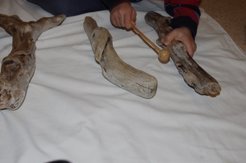Exploring Wood and Sound
As we continue to explore wood and its properties with the children, we wondered what the children might notice about the sound of wood. Would they notice differences in sound? How would they describe these differences? Would they notice the variances in wood, for example beach wood vs. a unit block?
In our provocations, we arranged the wood in sets of three pieces of similar size. The similar sizes were intentional to provoke the children to think deeper than determining any difference in sound as being due to the size of the piece.
For the first provocation, all of the wood was set on the table.
The teacher focussed the group on sound by tapping on the wood with a wooden mallet and asked, “What do you notice?”
“They are different.”
“What is different?”
“The sound of the wood.”
“How is it different?”
“This must be cedar, this must be alder and this is wood.”
“This one is like ‘ding, ding, ding,’ this one is like ‘dong, dong, dong,’ and this one is ‘dun, dun, dun.’”
The second time we introduced the provocation differently by having only one set of three pieces out at a time. Rather than diving right into the sound, we slowed down and asked the children to look at the wood, feel it and pick it up.
“What do you notice about these pieces of wood?”
“This one is smooth, and this one is flat.”
“This one is bumpy.”
“The side of this one is guilty.”
Once given the mallet to tap on the wood they were asked what they notice.
“This one sounds harder than this one. This one’s a little bit hard and this one’s light.”
“This one is crooked, this one is straight and this one is flat.”
“What else do you know about this wood?”
“Bumpy.”
“Guilty.”
“Guilty? What does that mean?”
“Like guilty you know? Like this, see it feels guilty.”
“Do you have another word for guilty?”
“No. Yes, guilt.”
“Where does wood come from?”
“The Beach.”
“Does all wood come from the beach?”
“No, not this one, this one’s from here.”
Teacher Reflections:
Upon reflecting on these conversations with the children, we are reminded about how literal and in the moment children are. During this exploration the children’s vocabulary was challenged. They practiced how to put their thoughts into words and how to share their ideas. Their relationship with the wood was also strengthened as they deepened their thinking and understanding.




